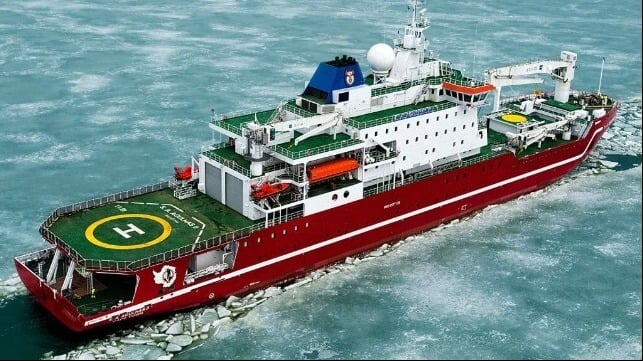History Repeats as Endurance Expedition is Briefly Stuck in Antarctic

Polar researchers undertaking the mission that hopes to find the wreck of Sir Ernest Shackleton’s lost ship the Endurance in the Antarctic briefly found themselves caught in a similar situation. It appears that history was repeating itself after the research and supply ship SA Agulhas II found itself stuck in the ice in the Antarctic near the spot they believe the Endurance was lost.
Six days ago the team announced that they had reached the Weddell Sea in the same area where Shackleton's Endurance sank in 1915. Knows as one of the most challenging places on earth, temperatures dropped to minus 10C and the team encountered an unnerving experience after their research vessel also got stuck in ice.
Endurance found itself trapped in the Weddell Sea over a century ago. The vessel drifted helplessly around the Weddell Sea for 10 months unable to break free of the ice. The wooden hull ship was confronted by the constant crushing pressure of the ice before it finally succumb to the pressure and broke apart and sunk. Shackleton and the team made their escape on foot through the deep snow and harsh environment before Shackleton made a daring crossing in a small lifeboat to reach civilization and rescue for his team.
The new expedition, the second by the team in three years, set out in January on the hundredth anniversary of Shackleton’s birth to search for his lost vessel. The wreck of Endurance is thought to lie in about 3,000 meters of water deep below the Antarctic ice. Their prior attempt in 2019 was forced to turn back after the loss of equipment and the unrelenting ice failed to give up any of its secrets.
“After a tense few hours stuck in the ice, the experience of Captain Knowledge Bengu and his crew really shone through as SA Agulhas II broke away and was able to continue the search for Endurance,” reports the team in their latest update.
They reached the area of the Weddell Sea on February 16 and the following day reported that they had made history when their underwater vehicle was deployed and reached the seabed for the first time. As late as February 20, they were still reporting that the ice conditions were remaining favorable calling the upcoming days critical to their mission. The ice is constantly moving in the area and can rapidly change.
The team is working from the South African Polar vessel, SA Agulhas II, a best-in-class vessel operated by African Marine Solutions. Built at the STX shipyard in Finland and launched in 2012, SA Agulhas II is 440 feet long and strengthened for ice-class navigation. It is polar class five meaning it is capable of operating year-round in medium first-year ice, which may include old ice inclusions. Its ice breaking performance is such that the ship can force a passage through level, one-meter thick ice at a speed of 5 knots.
During the 2019 expedition, the team encountered similar difficult ice conditions. The captain used his skills and experience to break through the ice but they were ultimately forced to suspend the expedition short of their target to find the lost vessel. The team of 50 is determined this year to continue with the expedition equipped with underwater robots, helicopters, and other state-of-the-art technology.
They are deploying advanced underwater technology to locate the wreck. The specially built hybrid autonomous underwater vehicles called Sabertooths have been fitted with high-definition cameras and side-scan imaging capability and can search and map large patches of the ocean floor to depths of up to 4,000 meters sending the data to the surface in real-time.

that matters most
Get the latest maritime news delivered to your inbox daily.
If the Endurance is found, the wreck will be surveyed by the Sabertooths laser scanner to produce a 3D model and full photogrammetric coverage of the wreck and its debris field. The resulting graphical data will be precisely scaled allowing the wreck, together with its equipment, fittings, and contents, to be recorded to a level of accuracy comparable to that of an archaeological survey on land.
The expedition plans to be at sea for 35 days, but the mission can be extended up to 45 days if required.
